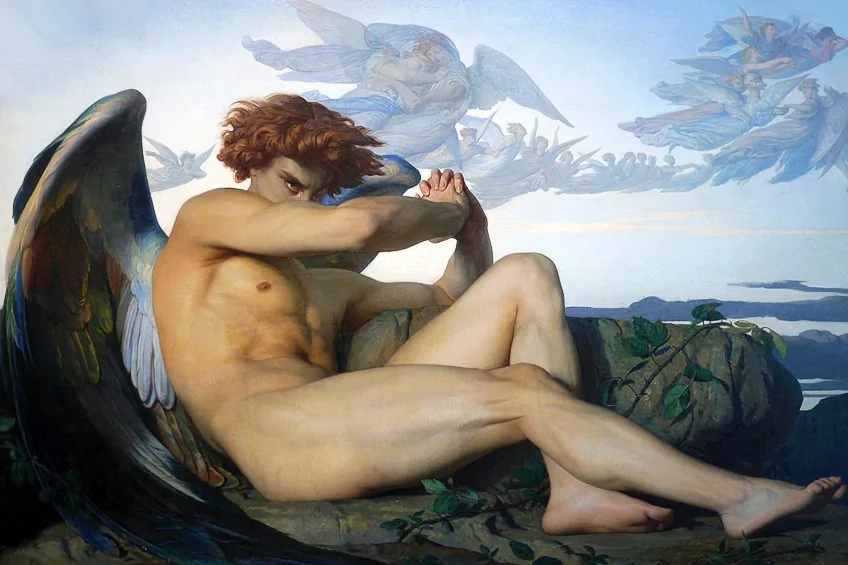“Fallen Angel” by Alexandre Cabanel – The Painting of Lucifer
Many masterpieces came to light during the era of Academism. Fallen Angel (1847) by Alexandre Cabanel was one of the most famous artworks to come about from this era of art. Cast from heaven and landing in a strange and outcast place, Fallen Angel depicts Lucifer the moment before he rises again, filled with emotion and incredible detail. We will be discussing in depth the beautiful masterpiece that is Fallen Angel in the article below.
Contents
Artist Abstract: Who Was Alexandre Cabanel?
French artist Alexandre Cabanel, whose work focused on religious, classical, and historical subjects, was born in the city of Montpellier in France on September 28th in 1823. His interest in art began early, and when he was 10 years old, he joined a small art school in his hometown. He was granted the chance to study at the École des Beaux-Arts in Paris when he was 17 and elected to continue his painting education.
He initially displayed his art in public in Paris in 1844 at the Salon, where he also received the Prix de Rome in 1845.
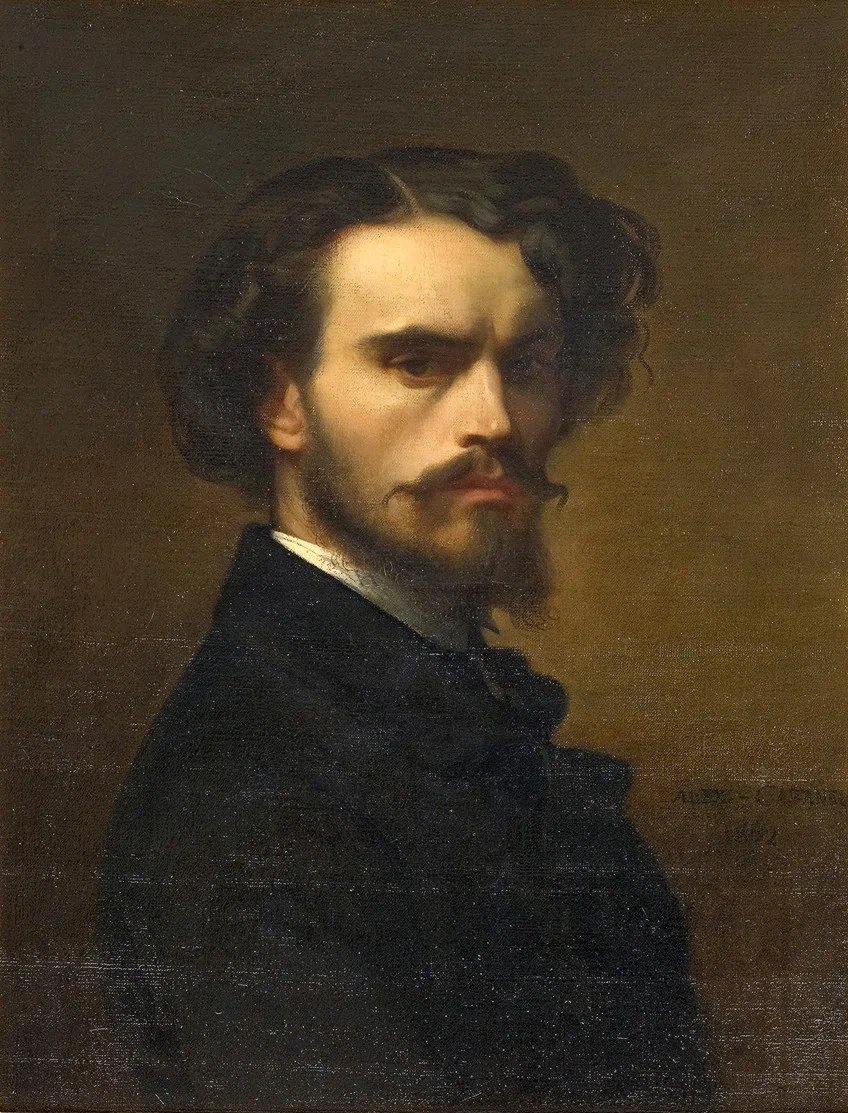
After his exhibition of his work at the Salon in Paris, he quickly became a favorite. His work lay strongly in the Academic style but held strong influence from the Rococo style too. His work was highly influential in the French art world at the time of his being and he was often made the juror of the Paris Salon. He studied at the École des Beaux-Arts in 1864 and was appointed as a teacher. Up until he died in 188, he taught numerous artists at École des Beaux-Arts.
Today, his works are showcased in many of the world’s most prestigious art exhibitions, including the Louvre and Musée d’Orsay, which are both located in Paris, as well as other well-known museums.
Fallen Angel (1847) by Alexandre Cabanel in Context
Below we will be delving into deeper detail about the painting Fallen Angel a painting of Lucifer by the French artist Alexander Cabanel. It will include a contextual analysis describing why Cabanel created the painting and what inspired him to paint it, as well as a formal analysis of the subject matter and the stylistic characteristics of the painting.
| Artist | Alexandre Cabanel (1823 – 1889) |
| Date Painted | 1847 |
| Medium | Oil on canvas |
| Genre | Religious painting |
| Period/Movement | Academicism |
| Dimensions (cm) | 121 x 189.7 |
| Series/Versions | An earlier version was created as a study of the painting in 1846 |
| Where It Is Currently Housed | Musée Fabre, Montpellier, France |
| Price of Artwork | Unknown |
Contextual Analysis
The Fallen Angel, a painting of Lucifer, is one of Cabanel’s most famous artworks. During the year 1847, Cabanel was 24 years old and was flourishing in his artistic career, on his way to becoming one of the first geniuses of French academic painting. He earned the “second first place award” for the Prix de Rome, which entailed a prize of a fellowship for French artists to live in Rome and study the Classical masters for three years. During his time in Rome, he submitted numerous artworks to the jury in Paris, where many of these artworks could be considered Renaissance paintings.
There, he also was exposed to Renaissance-style paintings and studied under Renaissance painter François Édouard Picot.
He painted many Renaissance paintings during this time and one could also consider Cabanel as a Renaissance painter himself. Cabanel’s early work was focused on religious themes with his paintings displayed in the Salon in Paris. These paintings, however, lacked emotion and were seen as playing it safe. In 1846, Cabanel hit a spanner in the works when he created a painting depicting Orestes, son of Agamemnon, which the academy rejected.
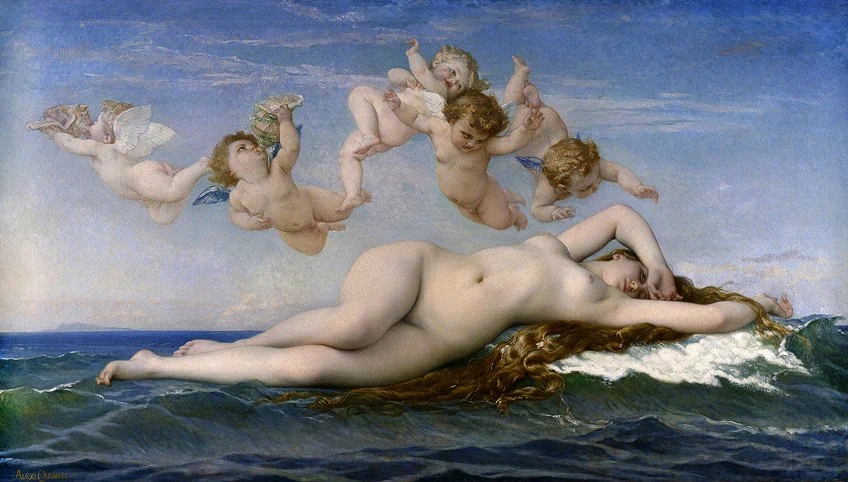
Just after this painting, he created the famous painting, Fallen Angel. Another extremely well-known and respected piece of art that Cabanel painted was The Birth of Venus (1863), which is located at the Musée d’Orsay in Paris. The painting caused quite a reaction among critics and is considered a masterpiece of the French academy art style.
Within his numerous Academic paintings of Biblical and mythological figures, he also created and became famous for his portraits and was sought out frequently for them.
He allegedly produced over 200 portraits, most of which were of women. He also obtained a job painting the slats and ceiling of the Salon of the Péreire Mansion in the 1850s and 1860s. Poet and writer John Milton and his poem Paradise Lost (1667) inspired Cabanel’s painting Fallen Angel. This was also the first depiction of Lucifer submitted to the Salon by a student. The painting indeed stirred up the crowd and caused some drama.

Religious and historical paintings usually included depictions of saints, angels, and Christ; however, the Salon judges were shocked by this depiction of Lucifer as a handsome man and were further unimpressed by it. Cabanel told his acquaintance Alfred Bruyas that he was unable to comprehend the criticism and felt as follows: “That’s my reward for all the trouble I gave myself not to submit an average piece of work.”
The judges thought that the execution of Lucifer was wrong and that the painting was a mess as well, as it was considered far too Romanticist.
Cabanel was proud of this work as he considered it above average. For three years the judges did not approve of this work, but by the end of the three years, the judges finally acknowledged it as a masterpiece. The painting is currently located at the Musée Fabre in France.
Formal Analysis of Fallen Angel Painting by Alexandre Cabanel
Fallen Angel by Alexandre Cabanel is a painting of Lucifer from the moment that he was cast out of Heaven, and is filled with emotion and intensity. The subject matter, color and light, shape and line, and the details of the painting will be discussed further below.
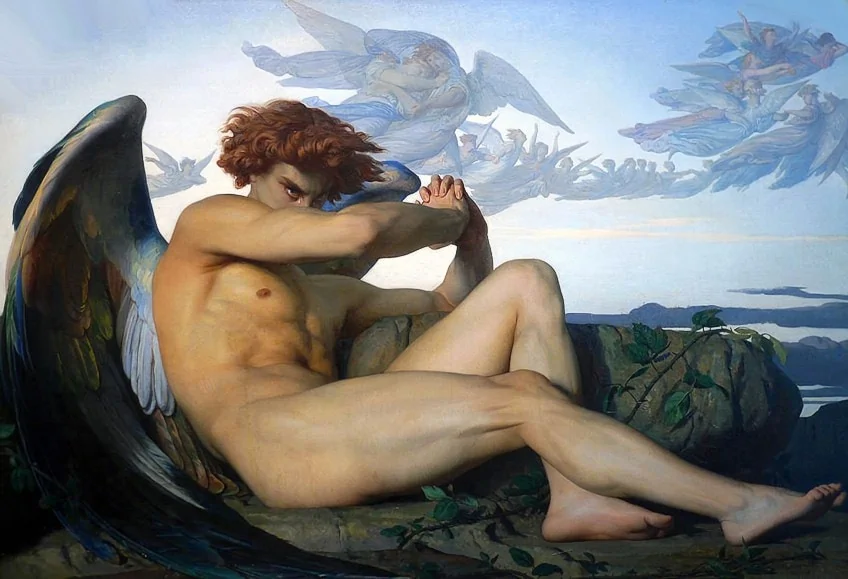
Subject Matter
In the Fallen Angel painting, we see the nude figure of Lucifer lying in a striking pose on a rocky surrounding. He is leaning tensely in a half-reclined position against a flat-topped rock. He is seen heightened above the surrounding terrain of a mountainous region, which suggests he is on the top of one of the mountains in the painting. Surrounding him, we see wreathed green vine wrapped over the top of the rock to the right of Lucifer and just below his legs.
Above Lucifer and assumingly behind him, we see several angels floating and flying past, wrapped within each other in the boundless stretch of the sky.
They are blue in hue, creating a blend with the blue color of the expanse of the sky. The angels seem to be celebrating the casting out of Lucifer from Heaven, which would sadden him. The angels are seen wearing flowing clothing with blue cloth wrapping around their bodies. The angels are almost transparent, which could symbolize their connection to the heavens.
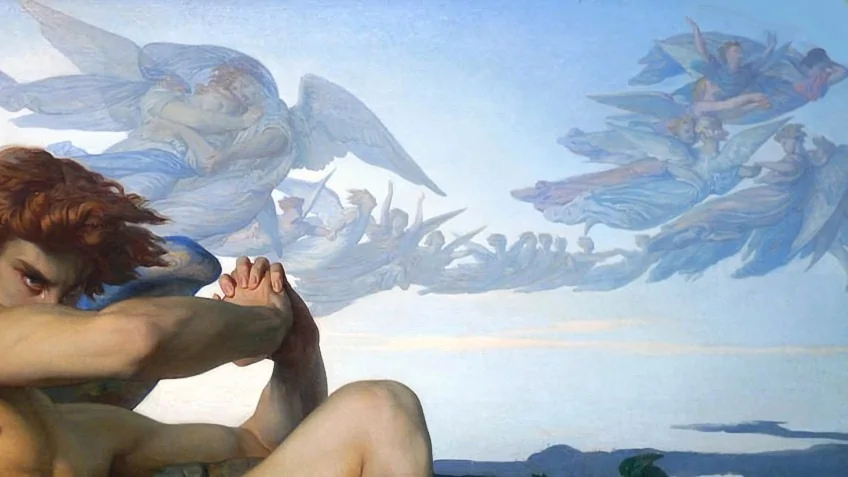
In the composition of the painting, the focal point is Lucifer as he takes up most of the space in the painting with his outstretched posture and large wings. Lucifer is depicted in the nude and his muscles are well defined with his physique seemingly perfect. He is seated in a way that seems as if he is posing, which is contrasted with the fact that he has just fallen from the heavens. This depiction was a completely different step away from the usual horrible and terrifying depictions of the Devil.
We see the majority of his right wing on the left side of the composition. The feathers are bent slightly as they touch the rugged surface of the ground.
His hair is bushy, golden-brown in color, and flowing in the wind, which indicates the weather at the moment of Lucifer sitting on the mountain. He supports his sitting position with his left arm, partially hidden, and rests on the rock behind him. He is holding up his right arm at a nearly 90-degree angle. The fingers of both hands are interlaced in a grasp.

In front of his face is his right arm, which is slightly lowered, displaying just the eyes and the start of his nose. His gaze is intense and full of emotion, and it appears as if he is intentionally hiding the lower portion of his face with his right arm. It almost seems as if he is covering his face in humiliation, although he fails to hide his emotion through his eyes.
In his right eye (our left), we see the majority of his face. In this eye, a teardrop is seen about to fall from it. A more shaded and hidden teardrop is also seen partially hidden in his left eye.
His expression is almost scowling, filled with rage and sadness. This expression is what the painting is widely known for. Considering the context behind the painting, this expression is accounted for. Lucifer’s eyes are staring straight ahead of him and could tell his story without the use of words. The emotions being felt by him are evident and plentiful.

He is angry, wrathful, and almost determined as he is about to rise to become the ruler of the underworld. His expression is intense and smoldering due to the position of being cast from heaven as one of the most powerful angels.
His position and the tears in his eye display his determination and readiness to attack.
Color and Light
In the Fallen Angel painting, the dark greens of the intertwining vines and the dark browns of the rocks create a juxtaposition of color against the lighter-colored Lucifer in the foreground of the painting. His skin tone shines brightly against the dark-hued setting, possibly symbolizing the importance of the subject matter being Lucifer. The background of the heavens shines with lighter shades of blue.
The light blue colors within the Devil’s wings almost blend in with the background, symbolizing a past connection with himself and the heavens above.

The lower part of Lucifer’s wings contains darker blues and darker browns and, as the wing progresses upward, it turns into a lighter brown, white, and light blue color palette, which blends into the heavens above. Harsh coloring was not used by Cabanel in Fallen Angel.
Instead, a more Rococo-style use of coloring was done, creating a harmonious feel throughout the painting by using soft colors and making use of light and shading.
This brings the use of color and value together. Lucifer’s hair is colored in an intense copper, almost like fire, symbolizing the flames of anger and anguish flowing through him. The use of light has been used to define his body, creating an angelic-like form.
Shape and Line
We observe a pleasing interaction of shapes and lines in Fallen Angel by Alexandre Cabanel, with a focus on horizontal and curving lines. As an illustration, consider how the numerous angels in the background combine to form a shape similar to that of Lucifer in the foreground.
Additionally, Lucifer’s enormous wing – which extends from the rocks in the forefront to the heavens and connects the lower and top parts of the picture – makes the left side of the composition more rounded and shrouded.
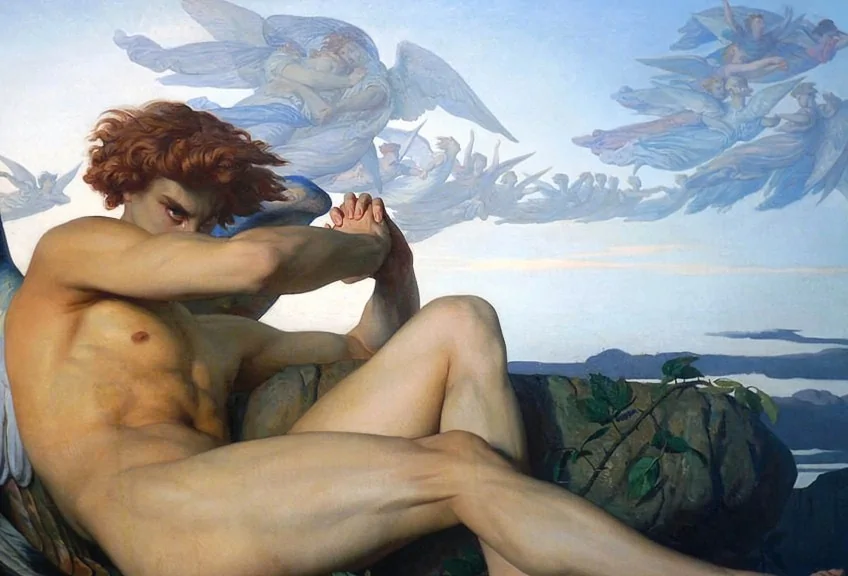
Compositionally, the right side of the painting is more open with a gap created to give a view, although limited, of the landscape and the dark looming clouds. The greenery, Lucifer’s wings, and his body all have curved lines. His posture is partially upright, and his upper torso similarly combines curved and vertical lines.
Details and the Beauty Within
Although Cabanel obtained knowledge and exposure from the great masters of painting with styles of Renaissance and ancient Roman art and sculpture, Fallen Angel has been described as having a Romantic aesthetic, which would make sense given the subject matter.
However, this composition still demonstrates Cabanel’s mastery of art and his classical style, which has that distinctive naturalism.
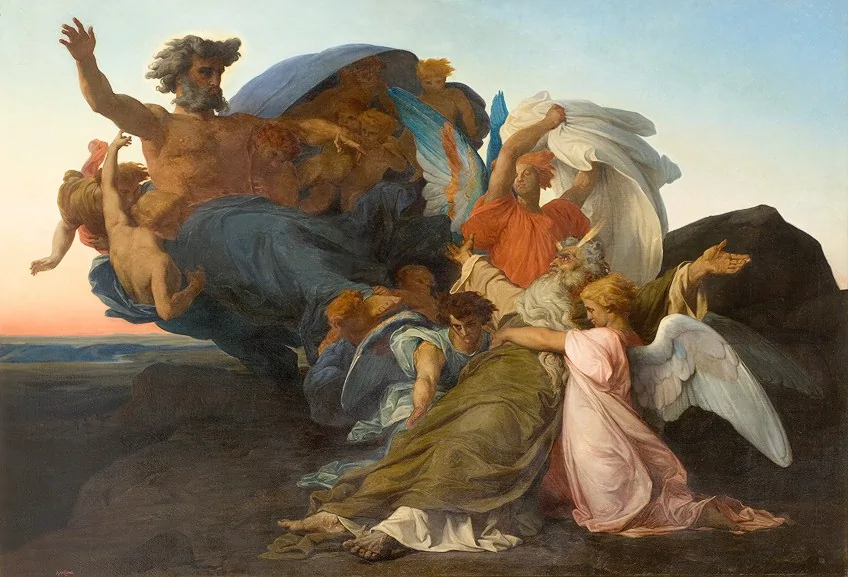
Cabanel portrayed Lucifer as a handsome figure expelled from Heaven, depicting him as a young man with a great physique, which one would expect to see in Classical Roman sculptures. Through many art sources, Lucifer is ironically described as a “handsome devil.”
Due to its widespread reproduction, the painting has nearly taken on the role of a poster boy for beauty, serving as a picture of the “bad boy” that so many people seem to adore. The beauty of the painting continues to put those who view it in complete awe with its detail and different depiction of Lucifer.
Take a look at our Fallen Angel painting webstory here!
Frequently Asked Questions
What Kind of Painting Is the Fallen Angel?
Fallen Angel was created by French artist Alexandre Cabanel in the medium of oil on canvas in 1847. The style is that of Academism and the subject matter of a nude portrait is increasingly common in visual art.
Where Is the Fallen Angel Painting Currently Located?
Fallen Angel (1847) is currently located at the Musée Fabre in Montpellier, France, which also happens to be the artist’s hometown. The museum further put up an exhibition known as Alexandre Cabanel, The Tradition of Beauty, in 2010.
What Is the Story Behind the Fallen Angel?
The Fallen Angel (1847) painting by French artist Alexandre Cabanel showcases the devil laying on a rock at the moment he was cast from Heaven for disobeying God. The painting drew inspiration from John Milton’s poem, Paradise Lost (1667).
Jordan Anthony is a Cape Town-based film photographer, curator, and arts writer. She holds a Bachelor of Art in Fine Arts from the University of the Witwatersrand, Johannesburg, where she explored themes like healing, identity, dreams, and intuitive creation in her Contemporary art practice. Jordan has collaborated with various local art institutions, including the KZNSA Gallery in Durban, the Turbine Art Fair, and the Wits Art Museum. Her photography focuses on abstract color manipulations, portraiture, candid shots, and urban landscapes. She’s intrigued by philosophy, memory, and esotericism, drawing inspiration from Surrealism, Fluxus, and ancient civilizations, as well as childhood influences and found objects. Jordan is working for artfilemagazine since 2022 and writes blog posts about art history and photography.
Learn more about Jordan Anthony and about us.
Cite this Article
Jordan, Anthony, ““Fallen Angel” by Alexandre Cabanel – The Painting of Lucifer.” artfilemagazine – Your Online Art Source. September 2, 2022. URL: https://artfilemagazine.com/fallen-angel-by-alexandre-cabanel/
Anthony, J. (2022, 2 September). “Fallen Angel” by Alexandre Cabanel – The Painting of Lucifer. artfilemagazine – Your Online Art Source. https://artfilemagazine.com/fallen-angel-by-alexandre-cabanel/
Anthony, Jordan. ““Fallen Angel” by Alexandre Cabanel – The Painting of Lucifer.” artfilemagazine – Your Online Art Source, September 2, 2022. https://artfilemagazine.com/fallen-angel-by-alexandre-cabanel/.


